Sewage Pollution a Culprit in Indian River Lagoon
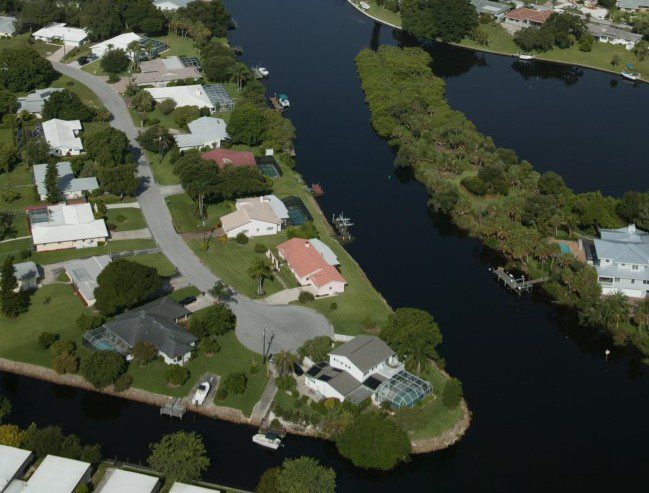
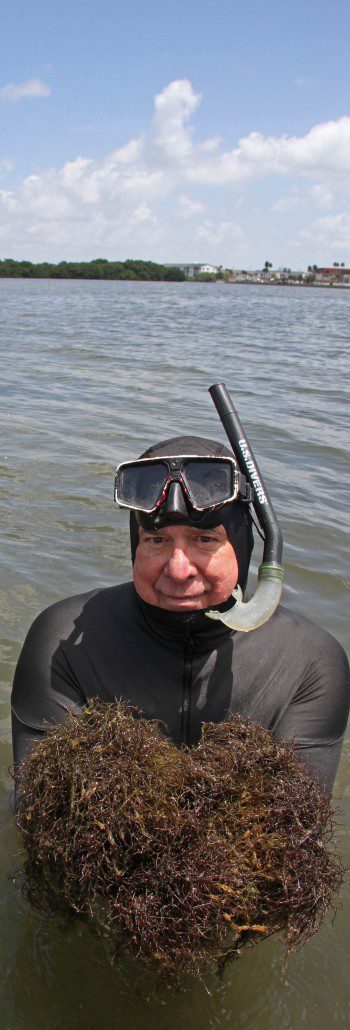
Dr. Brian Lapointe, Research Professor for the Harbor Branch Oceanographic Institute at Florida Atlantic University has spent decades studying the impact of humans on aquatic ecosystems. Photo courtesy of Florida Atlantic University, Harbor Branch.
Science points to proliferation of septic tanks in loss of seagrass and wildlife
The Indian River Lagoon is a narrow channel of brackish water that extends nearly 160 miles down the spine of Florida’s Atlantic coast. Although not as well known to outsiders as the Everglades or Florida Keys, the Indian River Lagoon (IRL) is an “estuary of national significance” and vitally important to many species of wildlife, including endangered manatees and sea turtles. The estuary also contributes significantly to Florida’s economy. For those reasons, the environmental health of the IRL is, in many ways, essential to the health of Florida’s east coast.
Given the importance of the IRL, it was alarming in 2013 when it was discovered that more than 162 manatees, 300 pelicans and 76 bottlenose dolphins–all in the northern IRL system of lagoons and inlets–had died of unknown causes. High casualty rates for these species have continued during the last year, with another 49 manatees dead as of Aug. 29, 2014. These animals are iconic symbols of the state, much like the alligator and panther, and tourists come to the IRL to see them.
Their demise, however, was more than a blow to tourism. It also indicated a much more serious problem with the waterway itself. Something was wrong with the complex ecosystem of the IRL, something serious enough to kill wildlife and perhaps threaten the safety of the humans who live, work and play in the area.
“What is a scientist after all? It is a curious man looking through a keyhole, the keyhole of nature, trying to know what’s going on.” – Jacques Cousteau
Dr. Brian Lapointe, a research professor for Florida Atlantic University’s Harbor Branch Oceanographic Institute in Fort Pierce, Fla., has studied marine environments since the early 1970s. Much of his work during the last four decades has involved the impact of humans on aquatic ecosystems, specifically the effect of sewage on fish and plant life. His research has taken him from the Keys to the Florida gulf coast to the IRL and all around the Caribbean region.
In 2011, he began looking through the keyhole at the Indian River Lagoon. The basis of his research in the IRL was rooted in nutrient science he developed in the Florida Keys back in the 1980s.
“The process I developed in the Florida Keys involved the use of stable nitrogen isotopes to fingerprint different sources of nitrogen,” explained Lapointe, who grew up in South Florida and received a Ph.D. in Marine Biology from the University of South Florida. “This is vital to determining the source of the problem, because it allows us to identify whether it is agricultural nitrogen from farms or sewage nitrogen that is being discharged locally. What the nitrogen isotope studies have told us so far is that there is a very strong wastewater nitrogen signal (in the IRL).”
The high nitrogen concentrations in the lagoon can come from a variety of sources: agricultural runoff from farms in Lake Okeechobee; urbanization in the Orlando area; and, closer to home, land and shoreline development in the six counties that comprise the Indian River Lagoon area. Many of the developments and individual homes in these six counties rely on septic tanks for the treatment of wastewater, especially in the northern IRL.
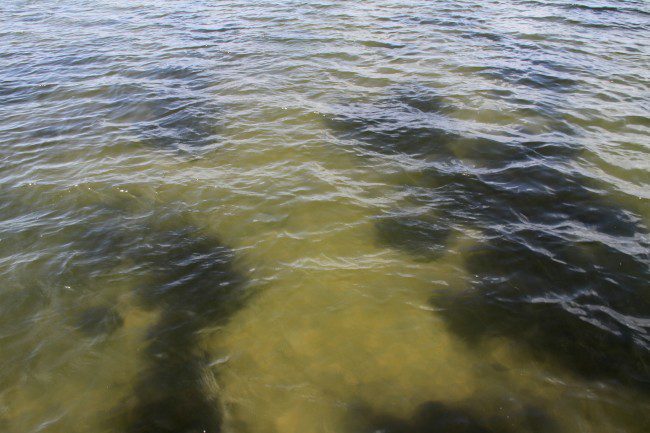
Macroalgae,sometimes referred to as seaweed, may contain toxic compounds that are suspected in the death of manatees in recent years. Photo courtesy of Florida Atlantic University, Harbor Branch.
Septic tanks typically work well for wastewater treatment, but are not ideal in this situation for a variety of reasons. The sandy soil in Florida, especially in the coastal areas, is more porous than most soils and does not filter contaminants well. When septic tanks are used in high densities, they create a significant amount of improperly treated wastewater that contains high levels of nitrogen that mixes with groundwater and can eventually make its way into the nearest major body of water, in this case the IRL tributaries.
High nitrogen levels, combined with lower amounts of phosphorus, produced unusually large phytoplankton “super blooms” and brown tides in the northern lagoon in 2011, 2012 and 2013. These phytoplankton blooms reduced the amount of light that penetrates to the bottom of the estuary, causing widespread seagrass die off. The loss of seagrass resulted in a loss of fish habitat, which had cascading effects throughout the IRL food web.
Furthermore, macroalgae (commonly referred to as “seaweed”) replaced the seagrasses in the low-light, high-nitrogen conditions. Lapointe suspects the manatees’ death could be attributed to their dietary shift from eating their normal diet–seagrass–to eating macroalgae, which he and colleagues have found contain toxic compounds. Likewise, E. coli bacteria in the lagoon may have contributed to the deaths of the dolphins and perhaps the pelicans.
Lapointe’s studies indicate that human waste is the primary source of the nitrogen in the algae blooms in the IRL estuary. Common sense also points to sewage contamination. The six counties that comprise the IRL estuary (Volusia, Brevard, Indian River, St. Lucie, Martin and Palm Beach) grew in population by more than 250,000 between 2000-2012. In the northern IRL, Volusia and Brevard counties alone have more than 170,000 septic tanks, many of which are located near the estuary.
Lapointe noted that high concentrations of septic tanks located in urbanized areas of the IRL watershed pose a significant threat to the environment. “The terrain is very flat, and the water tables are high,” he said. “In many cases the drain fields (for the septic tanks) are literally sitting in the groundwater during the rainy season. The severity of this problem is only just now being recognized.”
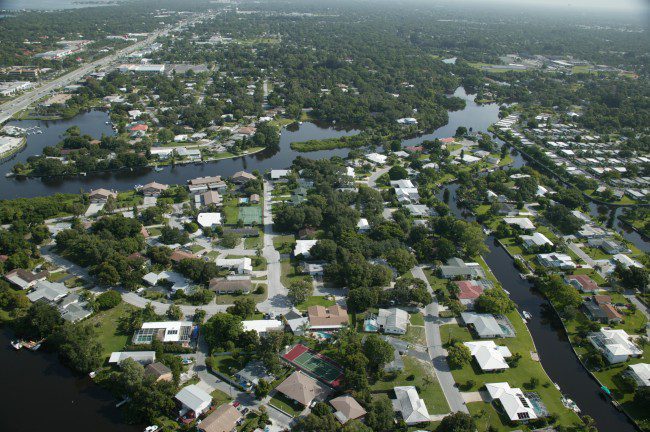
Sarasota County public-works officials addressed the problem of septic tanks in the Philippi Creek area several years ago and have since seen seagrasses recover and water quality improve. Photo by Bill Keefrey Studios.
For years, local and state agencies have developed Basin Management Action Plans (BMAPs) to reduce land-based nutrient loading to achieve Total Maximum Daily Load targets for the IRL.
“Based on my research, it’s possible that whatever benefits have been gained through the BMAP programs to reduce nutrient loading to the IRL from stormwater runoff have been offset by increased nutrient loading from the newly permitted septic tanks, which have been largely ignored in the BMAP process. The bottom line is the inadequate facilities to collect and treat human sewage from the expanding populations on the watersheds of the IRL. The task now is to reverse the trend and try to get the local ecosystem in recovery,” noted Lapointe.
“We protect nature not for nature’s sake, but for our own sake, because it’s the infrastructure of our communities.” – Robert Kennedy, Jr.
The problems unfolding in the Indian River Lagoon system are not unique, which should bring hope to the residents who rely on and enjoy the IRL ecosystem. In the 1990s, civic leaders, public-works officials and scientists faced a similar situation in the Phillippi Creek area of Sarasota County on Florida’s gulf coast. Near Phillippi Creek, 14,000 houses were served by septic tanks.
In 1997, after three years of study, it was found that fecal coliform pollution from septic tanks in the area reached a level that made the creek unsafe for humans and unhealthy for aquatic life. Clearly, something had to be done to stop the flow of sewage into the groundwater and, ultimately, Phillippi Creek. Leaders recognized the need for a sewer conveyance and treatment system, but faced the enormous challenge of funding and installation.
Public-works officials in Sarasota County studied the situation and evaluated various sewage-treatment options. Like much of Florida, the terrain is flat and the water table high. That meant the trenches for gravity sewer lines would be, by necessity, deep and difficult to dig. A gravity sewer system also would require numerous expensive lift stations to transport sewage to the nearest treatment plant.
Instead of traditional gravity sewers, the engineers recommended a vacuum sewer system from AIRVAC, a world-leader in the technology. Vacuum sewers were determined to be an excellent solution for wastewater collection in about 80 percent of the service area. Vacuum sewer lines require relatively shallow trenches, the lines don’t leak, and only a few vacuum stations are needed to convey sewage to the treatment plant.
The first system went into operation in 2003, and the county has since installed eight more vacuum systems, with only a few areas remaining to be connected. Thanks to the foresight of the Sarasota Bay National Estuary Program and community stakeholders, data now show that Sarasota Bay is much cleaner and safer than the IRL.
“Seagrasses in the creeks and bay are recovering nicely, and aquatic life has made a significant comeback,” said Lapointe. “I am convinced that this is a direct result of management actions that reduced nitrogen loading to the bay, including the elimination of septic tanks at Phillippi Creek. A similar success story is unfolding in Key Largo and Marathon Key, where a new vacuum sewer system is helping to reduce nitrogen and bacteria levels that were threatening the coral reefs.”
For the Florida Keys and Phillippi Creek in Sarasota, the issue at stake was not just the environment; it was the economy, along with human health and real-estate values. When fish and plant life die off and water becomes unsafe for human interaction, real-estate values plummet and jobs go away. What was once a vibrant outdoors-oriented, upscale community becomes a polluted, unhealthy wasteland. This could be the future for the IRL area. Left untreated, nitrogen and bacteria from sewage contamination will continue to choke out plant and marine life and make the local waterways unsafe for humans.
“For if one link in nature’s chain might be lost, another might be lost, until the whole of things will vanish by piecemeal.” – Thomas Jefferson
There are two hard issues facing residents living in the IRL watershed area. One is reversing the rising level of pollution that is apparently killing seagrasses, manatees, dolphins, pelicans and other aquatic life. The second, and perhaps more-difficult issue, involves raising public awareness of the problem and funding a solution. No one wants to pay for a new sewer system, and few people are eager to endure the disruption and hassles associated with a major construction project in the front yard. It takes significant political capital, and political courage, to champion issues such as septic-tank abatement and sewer installation, which are unglamorous and often expensive. Plus, it is a long-term solution that can take several years to implement. Taxpayers can be impatient when waiting to see results.
“The cost and inconvenience associated with infrastructure progress can be mitigated, to some degree, by doing the work in stages, as they did in Phillippi Creek and the Keys,” explained Lapointe. “With the right funding and scheduling in place, the cost and hassle factor become manageable and certainly well worth the results. It is entirely possible for Indian River Lagoon to be healthy again; we just have to have the political will and patience to make it happen.”
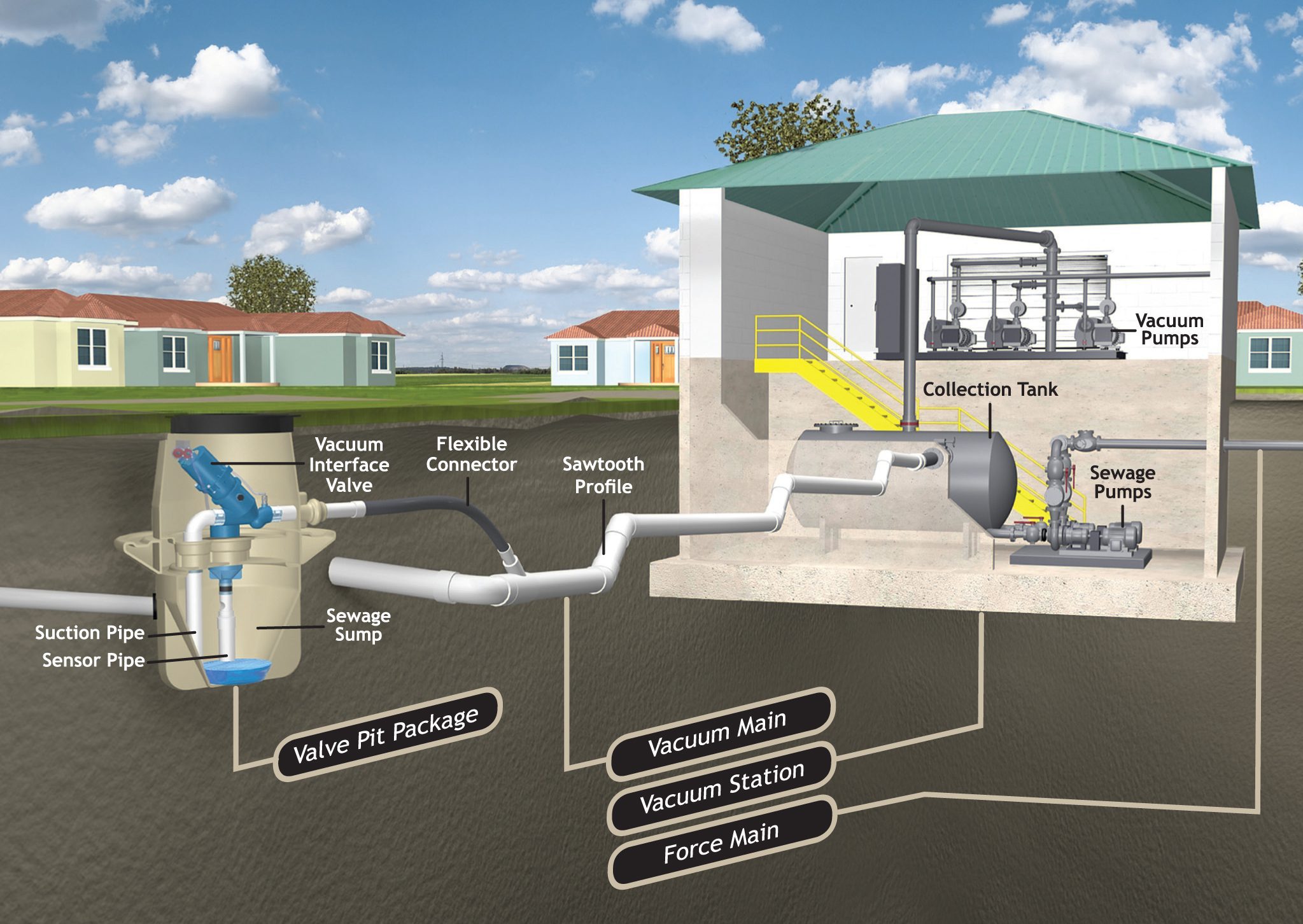
For more information about vacuum sewer technology, click this image for a video about this product, or visit www.water.bilfinger.com. Image courtesy of AIRVAC.
The choice becomes maintaining the status quo, which could mean the continued demise of wildlife and contamination of a vital body of water, not to mention the decline of property values and a hit to the local economy. Alternatively, leaders and residents can take action to solve the problem, which may involve some cost and inconvenience.
“Right now, we are at the point where people are finally getting it,” noted Lapointe. “Everyone has to look at themselves in the mirror and say, ‘what can I do to help solve this problem?’ We need to educate people about the situation and discuss the possible solutions. We have to deal with septic tanks, and sewage in general, in a better way, up and down the lagoon. Once we do that, we will begin to see a healthier situation in the lagoon and for the wildlife there.”
A healthier Indian River Lagoon is not only better for seagrasses, manatees and dolphins, it also protects property values and jobs for everyone in the region.
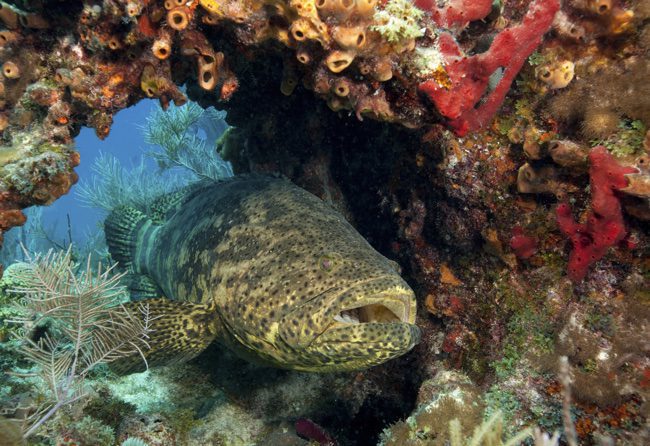
Coral reefs near Key Largo and Marathon Key have improved significantly since a new vacuum sewer system was installed, reducing the use of septic tanks. Image courtesy Stephen Frink Photograpy.
Modern Sewers Help Coral Reefs Make a Comeback
By Stephen Frink
I live in Port Largo, Fla., a subdivision of Key Largo, which has very deep and wide canals. I noticed an almost immediate difference in water clarity within six months of the completion of the sewer system in our community. I wasn’t necessarily surprised, because I was aware of septic-tank tests in which colored dye was flushed into the system, and, within an hour, it could be seen percolating out through the bedrock and into the canals. Switching from septic tanks to a modern sewer system made an obvious and almost immediate impact on the local marine environment.
My work takes me around the world, so I don’t often dive in my home waters. I dive Key Largo episodically, but that’s good, because if you see conditions infrequently, you notice the changes. That’s what has happened during the last two years in Key Largo.
In 2011, a new vacuum sewer system was installed in our community, and this summer I saw a lot of new coral growth and marine life, which is encouraging. In recent years, there was a lot of algae in those waters, primarily because of high nutrient levels.
There is no livestock in this area, and very few lawns and golf courses to fertilize, so sewage from septic tanks is almost certainly the source of the excess nitrogen that was present in the ocean. The nitrogen creates a breeding ground for algae, and algae cloaks the substrate and makes coral growth difficult, if not impossible. To thrive, coral reefs need a substrate free of algae. Reducing the nutrients present in the water will reduce algae.
I came to Key Largo in 1978 and saw a steady degradation of the coral reef, to the point where I thought it would never come back. Now I feel much more optimistic. There are other challenges to creating a healthy marine environment, like ocean acidification and coral bleaching from global warming, but important things can be done to help promote cleaner, healthier waters. It’s a cliché, but we have to think globally, but act locally. We can start by making wise decisions about our wastewater infrastructure.
Author Bio: Stephen Frink is a world-renowned underwater photographer who resides in the Florida Keys. With more than three decades’ experience, he is among the most frequently published underwater photographers. Frink also is the publisher of Alert Diver, a coffee-table magazine devoted to diver safety and the sea.
About Steve Gibbs
Steve Gibbs is a freelance writer in Memphis, Tenn., with more than 25 years of experience writing about public works infrastructure; e-mail: [email protected].


